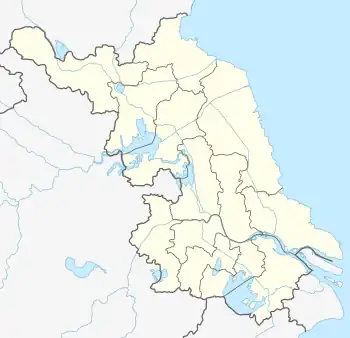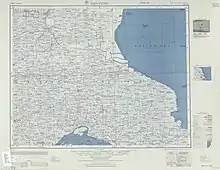Rugao
如皋市 | |
|---|---|
_001.jpg.webp) | |
 Rugao Location in Jiangsu | |
| Coordinates: 32°14′46″N 120°35′28″E / 32.246°N 120.591°E[1] | |
| Country | People's Republic of China |
| Province | Jiangsu |
| Prefecture-level city | Nantong |
| Area | |
| • Total | 1,576.47 km2 (608.68 sq mi) |
| Population (2018) | |
| • Total | 1,241,700 |
| • Density | 790/km2 (2,000/sq mi) |
| Time zone | UTC+8 (China Standard) |
| Postal Code | 226500 |
| Rugao | |||||||||
|---|---|---|---|---|---|---|---|---|---|
| Chinese | 如皋 | ||||||||
| |||||||||
Rugao (Chinese: 如皋; pinyin: Rúgāo) is a county-level city under the administration of Nantong, Jiangsu province, China, located in the Yangtze River Delta on the northern (left) bank of the river.
History

In 411, the western part of then Hailing (Taizhou) was separated from the county to create Rugao county, which named after a coastal village. During the Sui dynasty, the county was merged into Ninghai county. Restored in 952, the county was transferred to then Tongzhou in 1724.[2] Around the 1930s, Rugao was the most populous county in then Jiangsu province.[3] Two county governments of the New Fourth Army were established in the then county: Ruxi (literally Western Rugao) and Rugao (1940–5, was renamed as Rudong by the CPC in November 1945), while the Tongzhou-Yangzhou Canal marked the boundary between the two regions, during the Second Sino-Japanese War. Ruxi succeed to the designation Rugao in 1945, the reshuffling of territory came true only in January 1949, when the CPC totally controlled the area. On 1 June 1990, with approval of the State Council, Rugao was turned into a county-level city, which went into effect in 1991.[2]
Administrative divisions
At present, Rugao City has one subdistrict and 19 towns.[4]
- 1 subdistrict
- Rucheng (如城镇)
- 19 towns
|
|
Climate
| Climate data for Rugao (1991–2020 normals, extremes 1981–2010) | |||||||||||||
|---|---|---|---|---|---|---|---|---|---|---|---|---|---|
| Month | Jan | Feb | Mar | Apr | May | Jun | Jul | Aug | Sep | Oct | Nov | Dec | Year |
| Record high °C (°F) | 19.0 (66.2) |
25.6 (78.1) |
27.7 (81.9) |
32.4 (90.3) |
34.7 (94.5) |
37.0 (98.6) |
37.4 (99.3) |
38.0 (100.4) |
36.8 (98.2) |
32.0 (89.6) |
27.9 (82.2) |
22.5 (72.5) |
38.0 (100.4) |
| Mean daily maximum °C (°F) | 7.1 (44.8) |
9.4 (48.9) |
14.0 (57.2) |
20.1 (68.2) |
25.4 (77.7) |
28.4 (83.1) |
31.6 (88.9) |
31.1 (88.0) |
27.3 (81.1) |
22.5 (72.5) |
16.5 (61.7) |
9.8 (49.6) |
20.3 (68.5) |
| Daily mean °C (°F) | 2.7 (36.9) |
4.6 (40.3) |
8.7 (47.7) |
14.4 (57.9) |
19.8 (67.6) |
23.7 (74.7) |
27.5 (81.5) |
27.0 (80.6) |
23.0 (73.4) |
17.4 (63.3) |
11.3 (52.3) |
5.0 (41.0) |
15.4 (59.8) |
| Mean daily minimum °C (°F) | −0.6 (30.9) |
0.9 (33.6) |
4.5 (40.1) |
9.4 (48.9) |
14.9 (58.8) |
20.0 (68.0) |
24.2 (75.6) |
24.0 (75.2) |
19.5 (67.1) |
13.2 (55.8) |
7.1 (44.8) |
1.3 (34.3) |
11.5 (52.8) |
| Record low °C (°F) | −10.4 (13.3) |
−8.4 (16.9) |
−5.0 (23.0) |
−2.2 (28.0) |
4.8 (40.6) |
10.0 (50.0) |
16.5 (61.7) |
16.1 (61.0) |
9.3 (48.7) |
−0.3 (31.5) |
−3.8 (25.2) |
−13.4 (7.9) |
−13.4 (7.9) |
| Average precipitation mm (inches) | 50.9 (2.00) |
49.0 (1.93) |
74.5 (2.93) |
64.6 (2.54) |
92.1 (3.63) |
156.0 (6.14) |
206.4 (8.13) |
177.0 (6.97) |
91.7 (3.61) |
54.5 (2.15) |
56.9 (2.24) |
36.7 (1.44) |
1,110.3 (43.71) |
| Average precipitation days (≥ 0.1 mm) | 9.2 | 9.0 | 10.2 | 9.2 | 10.4 | 11.6 | 13.1 | 13.2 | 8.9 | 7.2 | 8.1 | 7.1 | 117.2 |
| Average snowy days | 2.9 | 2.6 | 0.7 | 0 | 0 | 0 | 0 | 0 | 0 | 0 | 0.2 | 0.7 | 7.1 |
| Average relative humidity (%) | 76 | 76 | 75 | 75 | 76 | 80 | 83 | 84 | 81 | 78 | 77 | 74 | 78 |
| Mean monthly sunshine hours | 125.3 | 127.4 | 155.3 | 178.3 | 182.2 | 135.5 | 170.1 | 186.6 | 167.3 | 169.3 | 140.3 | 142.2 | 1,879.8 |
| Percent possible sunshine | 39 | 41 | 42 | 46 | 43 | 32 | 39 | 46 | 46 | 49 | 45 | 46 | 43 |
| Source: China Meteorological Administration[5][6] | |||||||||||||
Education
- Baipu Middle school (1950)
Tourism
- Shuihui Garden
- Lingwei Taoist Temple
- Red Army Memorial Museum
Notable people
- Henry Lee, criminologist
- Zhu Qianhua, writer
- Huang Beijia, writer
- Xiaowei Zhuang, biophysicist
- Zhu Meifang, materials scientist
References
- ↑ Google (2014-07-02). "Rugao" (Map). Google Maps. Google. Retrieved 2014-07-02.
- 1 2 中国历史地名大辞典 [The Great Encyclopaedia of Chinese Historical Toponyms]. p. 1154. ISBN 978-7-500-44929-4.
- ↑ 江苏省志・人口志 [Jiangsu Provical Gazetteer, Volume on Demography]. Fangzhi Publishing House. pp. 90–8. ISBN 978-7-801-22526-9.
- ↑ "南通市-行政区划网 www.xzqh.org" (in Chinese). XZQH. Retrieved 2012-05-24.
- ↑ 中国气象数据网 – WeatherBk Data (in Simplified Chinese). China Meteorological Administration. Retrieved 25 June 2023.
- ↑ 中国气象数据网 (in Simplified Chinese). China Meteorological Administration. Retrieved 25 June 2023.
External links
- (in Chinese) Rugao government
- (in Chinese) Rugao City English guide (Jiangsu.net)
- (in English and Chinese) "Illustrated Album of Yangzhou Prefecture", from 1573 to 1620, has illustrations of Rugao